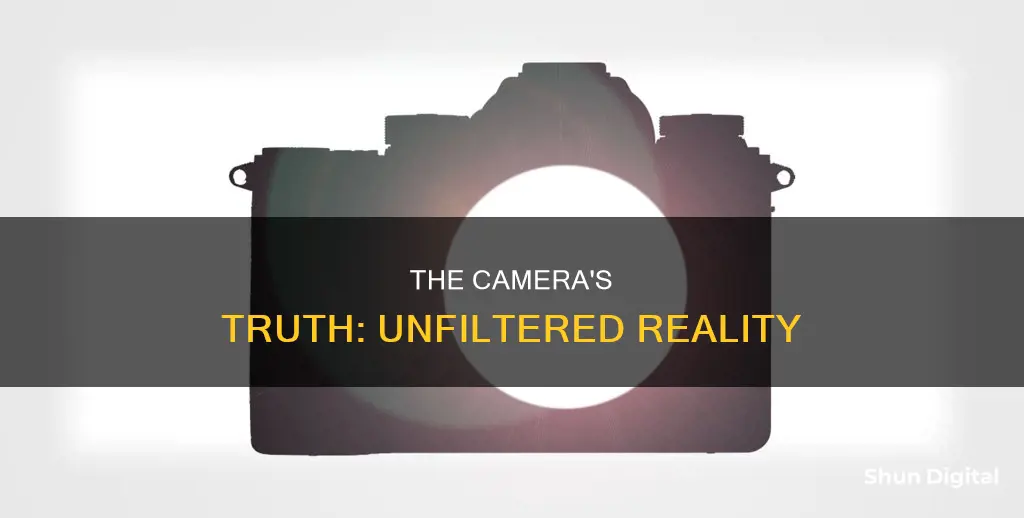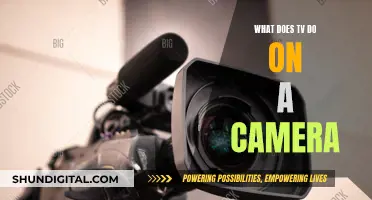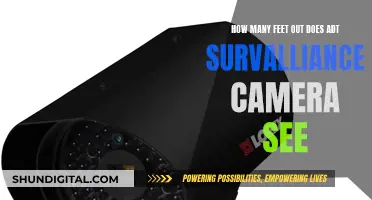
The camera never lies, or so they say. But what does the camera actually see? And is it the truth? The human brain possesses something called memory colours, a basic set of colours that are so familiar that even lighting variances cannot confuse them. Cameras, on the other hand, cannot remember what colour white is when it is captured under different types of lighting. They see in two dimensions, whereas we see in three. They can manipulate light in a way that our eyes cannot, but they cannot automatically correct colour casts. They do not observe.
Photography is an art, and the photographer is the artist. They decide what to capture, when to capture it, and how to frame it. They can alter the image to create the desired result. So, while the camera might not lie, it doesn't necessarily tell the whole truth either.
| Characteristics | Values |
|---|---|
| Dimensionality | Cameras see in 2D, humans see in 3D |
| Colour range | Cameras struggle to capture the full range of colours that the human eye can |
| Framing | Cameras capture a selective frame, which can be manipulated to tell a certain story |
| Subjectivity | Cameras are manipulated by the photographer's choices, cultural upbringing, experiences and biases |
| Authenticity | Cameras can be digitally manipulated to create an inauthentic image |
| Time | Cameras can capture moments in time that the human eye cannot process |
What You'll Learn
- Cameras are not objective, they construct reality rather than capture it
- The photographer chooses what, when, where, why, and how to photograph
- Cameras see in two dimensions, while humans see in three
- Cameras cannot automatically correct colour casts
- Photography is a two-part process, requiring both the camera and the photographer

Cameras are not objective, they construct reality rather than capture it
Cameras are often thought of as objective tools that capture reality as it is. However, this notion is misleading, as cameras construct reality through the choices made by the photographer rather than simply recording it.
Firstly, it is essential to recognise that cameras do not see the world in the same way that humans do. While we see in three dimensions, cameras capture images in two. This fundamental difference affects the way a scene is represented in a photograph. Photographers must also make choices about lenses, focal length, and camera position, all of which influence the final image. These technical decisions can alter the perception of space, with wide-angle lenses making the foreground appear larger and the background smaller, while longer lenses have a compressing effect.
Additionally, cameras have a unique relationship with light. They can manipulate light in ways that the human eye cannot, such as dialling up or down the amount of light coming in to create different effects. Cameras can also capture details in bright scenes and freeze fast-moving objects in a way that the human eye cannot. Thus, the camera's ability to interpret and manipulate light gives it a distinct perspective.
The photographer's role in deciding what to include or exclude from the frame is another way in which cameras construct reality. The choice of framing can significantly influence the narrative of an image. For example, including or excluding certain elements from the scene can shape the viewer's interpretation and create a specific desired effect. This selective process means that photographs often present an incomplete or biased perspective.
Furthermore, the belief that photographs capture "truth" fails to acknowledge the subjective decisions made by the photographer. From the camera angle to the moment of exposure, numerous factors influence the final image. These choices are influenced by the photographer's cultural background, experiences, and biases, making every photograph a manipulated representation of reality.
The notion of "truth" in photography is further complicated by the potential for digital manipulation. With the advent of new technologies, it has become easier to alter images, raising ethical concerns, especially in journalism. While some journalists view themselves as objective recorders of reality, digital manipulation allows for the creation of images that may mislead viewers and distort the truth.
In conclusion, cameras do not merely capture reality; they construct it through the technical choices, subjective decisions, and potential manipulations guided by the photographer's intentions and interpretations. Recognising this constructed nature of photography is crucial in understanding and interpreting images in our camera-saturated world.
Unexpected TV Camera Break: Impact and Aftermath
You may want to see also

The photographer chooses what, when, where, why, and how to photograph
The photographer's creative vision is the most important factor in the photographic process. They choose what, when, where, why, and how to photograph.
What to photograph
The photographer chooses what to photograph, and this decision is influenced by their interests, passions, and motivations. For example, photojournalists may be driven by a desire to expose an injustice or spark positive change, while fine art photographers may seek to challenge perceptions and present a new perspective on the world.
When to photograph
Timing is crucial in photography, and the photographer decides when to take a picture. This could be in response to a particular event or moment, or it could be a more considered, planned decision, such as waiting for the perfect light or conditions.
Where to photograph
The choice of location is key, and the photographer will select the vantage point from which to take the picture. This could be from a distance, capturing a wide view, or up close and personal, focusing on a specific detail.
Why photograph
Photographers are driven by a range of motivations. Some wish to inform, educate, or bear witness to important events. Others may be driven by a desire to express their unique perspective on the world or to challenge and thrill the viewer.
How to photograph
The photographer has a range of creative choices when it comes to how they take a picture. They can modify the image using different lenses and filters, and they can also set up an artificial scene. Post-processing techniques can also be used to alter an image, such as removing unwanted elements or enhancing colours.
Identifying Camera-Related Tweaks: A Comprehensive Guide
You may want to see also

Cameras see in two dimensions, while humans see in three
The saying, 'the camera never lies' has been around since the dawn of photography. However, this is not entirely true. Cameras see in two dimensions, while humans see in three. This is one of the major differences between what a camera captures and what the human eye perceives.
A camera's output is flatter and less dynamic than what we see with our eyes. Our eyes can easily interpret a wide range of colours and shades, whereas cameras often struggle to capture the same scene with the same level of accuracy and depth. This is why photographers have to adopt various techniques to get an image that comes close to what our eyes can see.
The images captured by cameras are also selective and framed, often isolating the subject from its surroundings. This can result in a photo that seems at odds with its environment, especially if viewed by someone unfamiliar with the location. In this way, the camera can distort the truth and present a constructed reality rather than an objective one.
Photographers make conscious and unconscious choices about what to include and exclude from a photo, based on their perspective and biases. These choices can influence the narrative and interpretation of the image. Furthermore, with the advent of digital manipulation, photographs can be altered to create a desired result, further distancing them from the truth.
While humans do see in three dimensions, it is important to note that our perception of the world is not entirely objective either. Our brains interpret the information received through our senses and construct our reality. This means that our understanding of the world is influenced by our cultural upbringing, experiences, and biases, just like a photographer framing a shot.
In conclusion, while cameras capture images in two dimensions and humans perceive the world in three, neither can be said to present an entirely objective truth. Both are limited by their respective capabilities and the subjective nature of interpretation.
Smart TVs: Are They Watching You?
You may want to see also

Cameras cannot automatically correct colour casts
The saying, "the camera never lies", has been in use since the dawn of photography. However, the camera does not tell the whole truth either. There are many differences between what the human eye perceives and what a camera captures. One such difference is that cameras cannot automatically correct colour casts.
A colour cast is an unwanted tint of a particular colour that affects a photographic image in whole or in part. It can ruin the mood, tone, and realism of an image. Colour casts are usually caused by differences in the colour temperature of the light source that illuminates a scene and the white balance setting on the camera. For example, if you are shooting indoors under tungsten light with your white balance set to daylight, your photos will have a yellowish colour cast.
While most digital cameras try to automatically detect and compensate for colour casts, they are not always successful. This is because the human eye and brain adjust and compensate for different types of light in ways that cameras cannot. Our brains figure out the context of a scene's light colour and automatically compensate for it. White balance adjustment in cameras tries to do the same thing, but it is not always accurate.
To avoid colour casts, photographers can adjust their white balance setting according to the light source they are using. White balance is the process of telling your camera what colour is white in your scene, so that it can adjust the colours accordingly. Most cameras have preset white balance modes, such as auto, daylight, cloudy, shade, tungsten, fluorescent, or custom. Photographers can also manually set their white balance using a grey card, a white piece of paper, or a colour checker.
If a colour cast cannot be avoided in-camera, it can usually be corrected in post-processing using photo editing software such as Photoshop, Lightroom, or GIMP. These software programs have various tools to correct colour casts, such as the white balance tool and the colour balance tool.
Trail Camera's Bat Vision: What They See After Dark
You may want to see also

Photography is a two-part process, requiring both the camera and the photographer
The idea that "the camera never lies" has persisted since the dawn of photography. While cameras do indeed capture what is in front of them, there are several limitations and human factors that influence what we see in a photograph.
Firstly, cameras have technological limitations. They see in two dimensions, whereas we see in three. They also have a more limited colour range and dynamic ability than the human eye. These limitations mean that photographers must employ various techniques to achieve an image that rivals what the eye can see.
Secondly, the photographer chooses what to include in the frame and from what perspective to shoot. This means that a photograph is often a selective, decontextualised version of reality. The photographer's cultural upbringing, experiences, and biases will influence these choices, and so the resulting image is one individual's interpretation of a moment in time.
Thirdly, photographs can be digitally altered, further manipulating reality. This has become increasingly common and more sophisticated with the advent of computer technology. While some journalists and photographers view this practice as unethical, others embrace it as a way to create the "perfect image".
Finally, the viewer's interpretation of a photograph is also influenced by their own experiences and biases. The act of viewing a photograph is, therefore, a highly subjective experience.
In conclusion, photography is indeed a two-part process requiring both the camera and the photographer. The camera captures the raw materials of space, light, and time, and the photographer interprets these through their choices of optics, settings, and post-processing. The resulting image is a constructed reality, a collaboration between the camera and the photographer, and is not necessarily an objective representation of truth.
How Subaru's EyeSight Camera Technology Enhances Your Driving
You may want to see also
Frequently asked questions
The saying goes, "the camera never lies", but this is not entirely true. Cameras are unable to interpret certain things, such as depth and colour, in the same way that the human eye can. Cameras also rely on a human to frame and capture an image, which can be subjective and biased.
The human eye, in combination with the brain's image processor, the Visual Cortex, can capture and process a much wider range of colours and lighting conditions than a camera. The human brain also possesses "memory colours", which allow it to recognise and process familiar colours, even in varying lighting conditions. Cameras lack this ability and must be manually adjusted to accurately capture colours.
No, a camera cannot capture objective truth. The act of taking a photograph involves a series of subjective choices, including what to include or exclude from the frame, the angle, and the lighting. These choices are influenced by the photographer's cultural upbringing, experiences, and biases.
The prevalence of photographic images has blurred the line between image and reality. Photographs can give the illusion of objectivity and are often perceived as more reliable than language in constructing, understanding, and testing reality. This has led to the emergence of "bureaucratic cataloguing", where institutions of control, such as the police, use photographic documents such as passports or identity cards to survey and control populations.
The advent of digital manipulation technology has further undermined the notion that photographs capture objective truth. Digital manipulation allows for the undetectable alteration of images, blurring the line between reality and construction. This has created ethical dilemmas, particularly in journalism, where the public's trust is essential.







